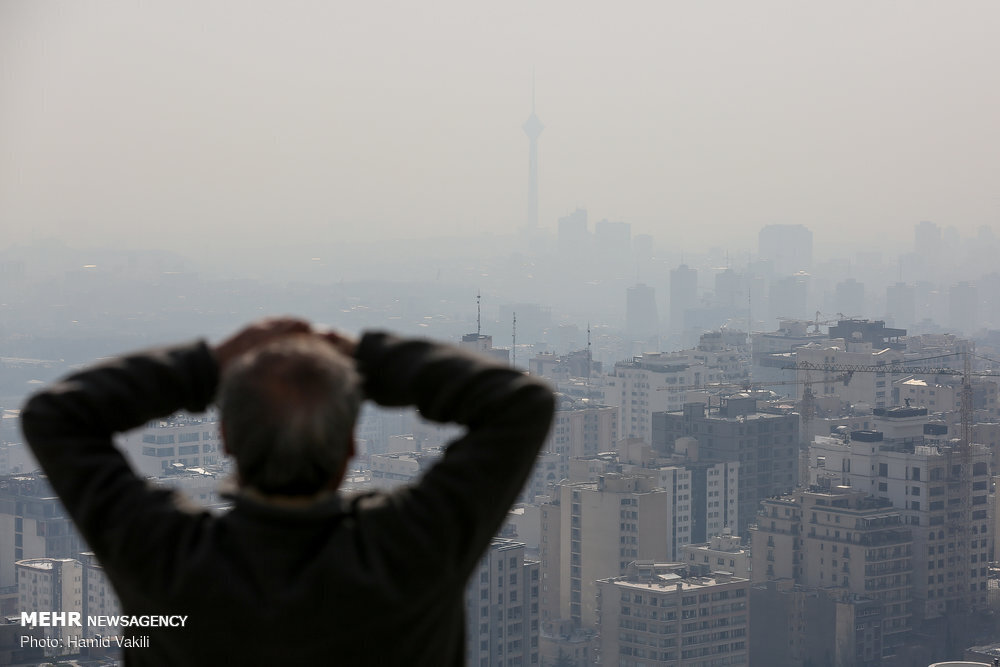Deaths attributed to air pollution increased by 87%

TEHRAN – During the last [Iranian calendar] year (March 2021-March 2022), the number of all deaths attributed to long-term exposure to PM2.5 particles increased by more than 87 percent compared to a year before, Abbas Shahsavani, head of air health and climate change department of the Ministry of Health, has said.
Exposure to air pollution in developed countries is the fourth leading cause of death in the world after metabolic risks, diet, and cigarette smoke. Meanwhile, in developing countries, air pollution is the third risk factor for death. In fact, global studies have shown that outdoor and indoor air pollution in urban and rural areas leads to more than seven million premature deaths every year.
Referring to the latest study of the Ministry of Health in Iran in the field of air pollution under the title “Quantification of health and economic effects attributed to PM 2.5 particulate pollution”, he explained that this study was carried out in 27 cities with a population of 35 million citizens.
The cities included Tehran, Ahvaz, Mashhad, Tabriz, Shiraz, Isfahan, Ilam, Sanandaj, Hamedan, Khorramabad, Arak, Karaj, Kermanshah, Abadan, Shahrekord, Yazd, Urmia, Kerman, Qazvin, Birjand, Qom, Zabul, Bojnord, Zanjan, Bushehr, Ardabil, and Zahedan.
Last year, the average concentration of suspended particles PM2.5 in 27 mentioned cities is more than 6 times the guideline of the World Health Organization (5 micrograms per cubic meter) and more than 2.5 times the national standard (12 micrograms per cubic meter).
In the city of Tehran, for 355 days, the average daily PM2.5 concentrations have been higher than the daily guidelines of the World Health Organization.
During last year, the healthy air quality of the studied cities decreased by five percent compared to a year ago.
The lowest concentration of suspended particles PM2.5 was related to Ardabil city, and the Ardabil citizens experienced 297 days of healthy air, the highest number among the cities.
The highest number of unhealthy days for all groups, very unhealthy and dangerous, are related to the cities that are facing the sand and dust storm phenomenon, including Zabul, Ahvaz, Kermanshah and Dezful, which has caused many adverse health effects on the health of the residents.
The average number of total deaths attributed to PM2.5 in adults aged above 30 years in 27 studied cities was 20,837. The phenomenon has claimed 6,398 lives in the capital city of Tehran.
Over the past year, the costs associated with mortality from the chronic obstructive pulmonary disease were estimated at $225 million. Also, lung cancer death costs are estimated at $201 million. The economic loss of lung cancer deaths attributed to air pollution is significantly higher than five years ago.
The number of cardiac ischemic deaths in the 27 studied cities was 4,923 on average and in Tehran was reported as an average of 1,322. The related costs were estimated at $1.932 million.
The average number of deaths due to stroke attributed to PM2.5 particles in 27 studied cities was an average of 1,972 people, and 666 people in Tehran. The costs associated with stroke deaths were estimated at $774 million.
But this trend stopped and increased in the [Iranian calendar] year 1399 (March 2020- March 2021), and the number of all deaths attributed to long-term exposure to PM2.5 particles increased by more than 87 percent a year later.
Also, the total cost related to deaths caused by all causes attributed to PM2.5 suspended particles is estimated at $8.17 billion last year, which has increased by more than 90 percent compared to a year before. Tehran bearded the highest loss.
Air pollution kills more than AIDS and malaria
The number of people who die annually from air pollution in the world is 6 times the number of people who die from malaria and 4 times those killed by AIDS.
The probability of death in children under the age of five in low-income countries due to exposure to air pollution is more than 60 times higher than in high-income countries. Also, the number of people who die annually from air pollution in the world is more than 6 times the number of people who die from malaria and more than 4 times the number of people who die from AIDS.
The guidelines of the World Health Organization in 2005 show that reducing the concentration of PM10 particles from 70 micrograms per cubic meter to 20 micrograms per cubic meter will reduce the death rate by 15 percent.
The World Health Organization estimated in 2019 that outdoor and indoor air pollution in urban and rural areas leads to more than 7 million premature deaths annually. Also, based on a report in 2019, it was found that in the world, on average, about 54 percent of premature deaths related to outdoor air pollution are due to ischemic heart disease and stroke.
Also, seven percent of premature deaths of lung cancer and 19 percent of premature deaths of chronic obstructive pulmonary disease are related to outdoor air pollution.
FB/MG
Leave a Comment